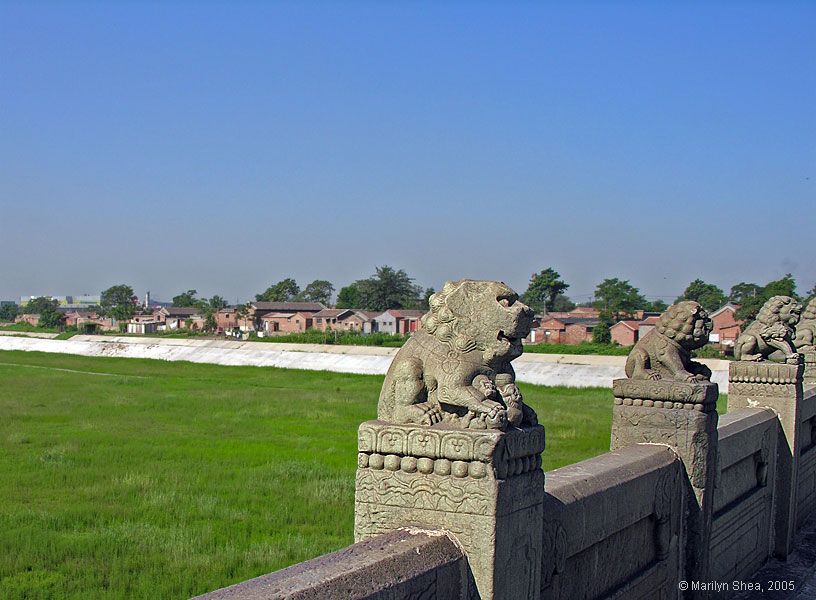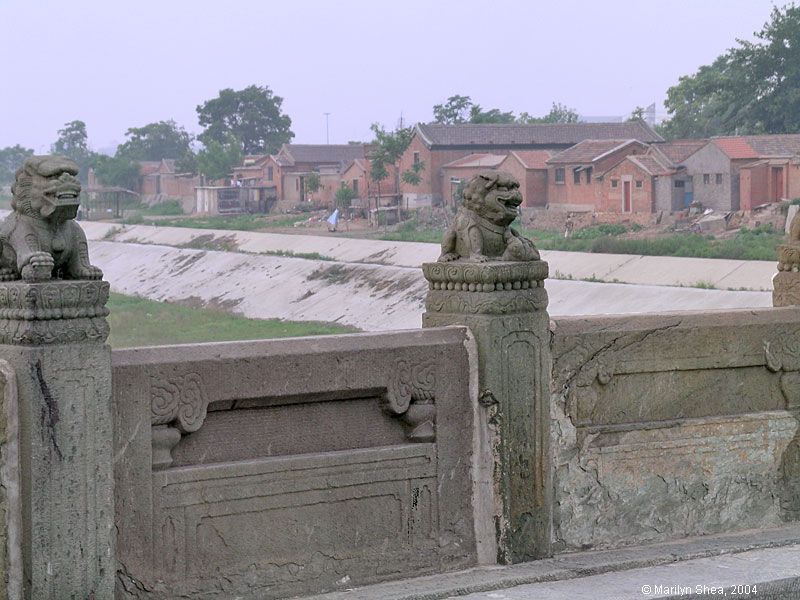[The Rev. W.S. Ament (M. Polo in Cambaluc, p. 116-117) remarks regarding Yule's quotation from Magaillans that "a glance at Chinese history would have explained to these gentlemen that there was no stone bridge over the Liu Li river till the days of Kia Tsing, the Ming Emperor, 1522 A.D., or more than one hundred and fifty years after Polo was dead. Hence he could not have confounded bridges, one of which he never saw. The Lu Kou Bridge was first constructed of stone by She Tsung, fourth Emperor of the Kin, in the period Ta Ting 1189 A.D., and was finished by Chang Tsung 1194 A.D. Before that time it had been constructed of wood, and had been sometimes a stationary and often a floating bridge. The oldest account [end of 16th century] states that the bridge was pu 200 in length, and specifically states that each pu was 5 feet, thus making the bridge 1000 feet long. It was called the Kuan Li Bridge. The Emperor, Kia Tsing of the Ming, was a great bridge builder. He reconstructed this bridge, adding strong embankments to prevent injury by floods. He also built the fine bridge over the Liu Li Ho, the Cho Chou Bridge over the Chü Ma Ho. What cannot be explained is Polo's statement that the bridge had twenty-four arches, when the oldest accounts give no more than thirteen, there being eleven at the present time. The columns which supported the balustrade in Polo's time rested upon the loins of sculptured lions. The account of the lions after the bridge was repaired by Kia Tsing says that there are so many that it is impossible to count them correctly, and gossip about the bridge says that several persons have lost their minds in making the attempt. The little walled city on the east end of the bridge, rightly called Kung Chi, popularly called Fei Ch'eng, is a monument to Ts'ung Ch'êng, the last of the Ming, who built it, hoping to check the advance of Li Tzu ch'eng, the great robber chief who finally proved too strong for him."--H.C.]
The Bridge of Lu-kou is mentioned more than once in the history of the conquest of North China by Chinghiz. It was the scene of a notable mutiny of the troops of the Kin Dynasty in 1215, which induced Chinghiz to break a treaty just concluded, and led to his capture of Peking.
This bridge was begun, according to Klaproth, in 1189, and was five years a-building. On the 17th August, 1688, as Magaillans tells us, a great flood carried away two arches of the bridge, and the remainder soon fell. [Father Intorcetta, quoted by Bretschneider (Peking, p. 53), gives the 25th of July, 1668, as the date of the destruction of the bridge, which agrees well with the Chinese accounts.--H.C.] The bridge was renewed, but with only nine arches instead of thirteen, as appears from the following note of personal observation with which Dr. Lockhart has favoured me:
"At 27 li from Peking, by the western road leaving the gate of the Chinese city called Kwang-'an-man, after passing the old walled town of Feuchen, you reach the bridge of Lo-Ku-Kiao. As it now stands it is a very long bridge of nine arches (real arches) spanning the valley of the Hwan Ho, and surrounded by beautiful scenery. The bridge is built of green sandstone, and has a good balustrade with short square pilasters crowned by small lions. It is in very good repair, and has a ceaseless traffic, being on the road to the coal-mines which supply the city. There is a pavilion at each end of the bridge with inscriptions, the one recording that K'anghi (1662-1723) built the bridge, and the other that Kienlung (1736-1796) repaired it." These circumstances are strictly consistent with Magaillans' account of the destruction of the mediaeval bridge. Williamson describes the present bridge as about 700 feet long, and 12 feet wide in the middle part.
[Dr. Bretschneider saw the bridge, and gives the following description of it: "The bridge is 350 ordinary paces long and 18 broad. It is built of sandstone, and has on either side a stone balustrade of square columns, about 4 feet high, 140 on each side, each crowned by a sculptured lion over a foot high. Beside these there are a number of smaller lions placed irregularly on the necks, behind the legs, under the feet, or on the back of the larger ones. The space between the columns is closed by stone slabs. Four sculptured stone elephants lean with their foreheads against the edge of the balustrades. The bridge is supported by eleven arches. At each end of the bridge two pavilions with yellow roofs have been built, all with large marble tablets in them; two with inscriptions made by order of the Emperor K'ang-hi (1662-1723); and two with inscriptions of the time of K'ien-lung (1736-1796). On these tablets the history of the bridge is recorded." Dr. Bretschneider adds that Dr. Lockhart is also right in counting nine arches, for he counts only the waterways, not the arches resting upon the banks of the river. Dr. Forke (p. 5) counts 11 arches and 280 stone lions.--H.C.]
From:
THE TRAVELS OF MARCO POLO: VOLUME II. THE COMPLETE YULE-CORDIER EDITION. IN TWO VOLUMES. Including the unabridged third edition (1903) of Henry Yule's annotated translation, as revised by Henri Cordier; together with Cordier's later volume of notes and addenda (1920)
PROJECT GUTENBERG

